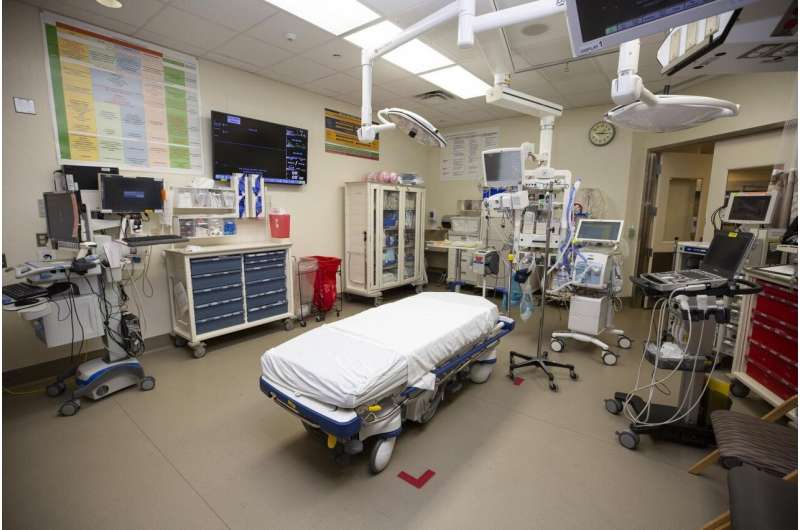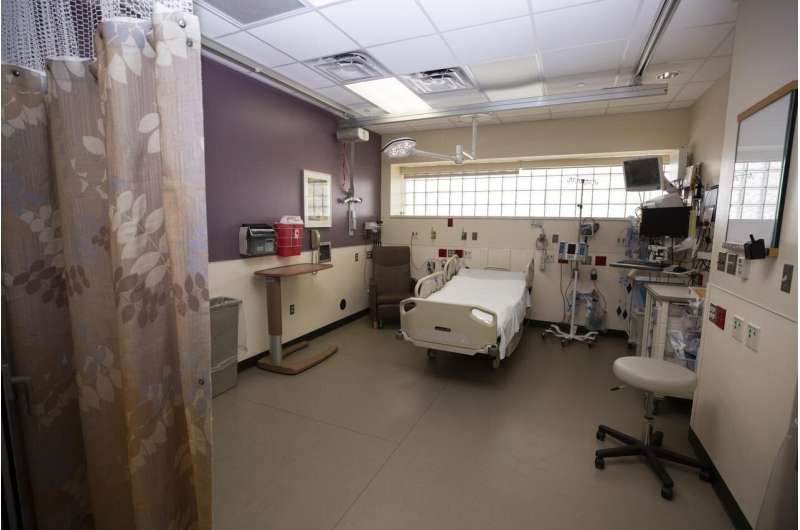Department-based intensive care unit improves patient survival rates

A new study found having an intensive care unit within the emergency department improved care and survival rates for the entire emergency department population.
"The time patients have to wait in the emergency department for inpatient critical care resources is increasing nationwide, and longer wait times for intensive care units have been associated with decreased survival rates," says Kyle Gunnerson, M.D., an associate professor of emergency critical care medicine at Michigan Medicine.
Gunnerson, the lead author on the study published in JAMA Network Open, examined Michigan Medicine's own emergency department-based intensive care unit, the Massey Family Foundation Emergency Critical Care Center—EC3, and its impact on the rest of the emergency department and the patients it serves.
"By applying cutting-edge critical care diagnostics and therapies to our sickest patients very early in their presentation to the emergency department, we were able to optimize their care in a way that improved outcomes and often reduced the need for an inpatient ICU admission," says Robert Neumar, M.D., Ph.D., professor and chair of emergency medicine at Michigan Medicine and the study's senior author.
Examining data
The EC3 is one of the most advanced emergency critical care centers in the country. The 7,800 square-foot unit opened in February 2015 and has five resuscitation trauma bays and nine patient rooms. The unit is adjacent to the main adult emergency department.
In the study, the research team collected data from electronic health records for all Michigan Medicine emergency department visits between September 1, 2012 and July 31, 2017, and divided them into a pre-EC3 implementation cohort and a post-EC3 implementation cohort. Then they examined 30-day patient mortality outcomes, as well as ICU admission rates, among all emergency department patients before and after EC3 implementation.
"By deploying this new critical care delivery approach in the EC3, we observed an improved survival rate among all of the emergency department patients in our data," says Gunnerson, the medical director of the EC3.
"Mortality rates decreased from 2.13 % pre-EC3 to 1.83% post-EC3 implementation, and the survival benefit was evident for up to 30 days after admission to the emergency department."
The research team also found a decrease in ICU admissions, from 3.2% pre-EC3, to 2.7% post-EC3.

"We were also able to safely decrease ICU admissions because we were able to rapidly initiate that level of care right in our own emergency department," Neumar says. "In addition to improving patient care within the emergency department, this strategy increased the availability of inpatient critical care resources to other patients already in the hospital or awaiting a transfer to our hospital."
Benjamin Bassin, M.D., an assistant professor of emergency medicine at Michigan Medicine and the EC3's director of clinical operations, explains that the findings of the study have an important impact on clinical care.
"Our study found that for every 333 patients that presented to our emergency room, we were able to save one life by utilizing our new clinical approach," says Bassin, a co-author on the study.
"At Michigan Medicine, we average about 250 emergency department visits each day, so an additional life was saved approximately every 36 hours because of this unit."
Future care
The EC3's medical team hopes this study proves the benefits of having a dedicated, emergency medicine department-based intensive care unit.
"We hope this study and the level of care we are able to provide in our EC3 will encourage other health systems to consider implementing an emergency medicine department-based intensive care unit in their own hospital," says Renee Havey, M.S., R.N., clinical nurse specialist of the EC3 and a co-author on the study.
Nathan Haas, M.D., an attending physician in the EC3 and a co-author on the study, agrees, "And if they can't build their own unit at this time, we hope this study offers them strategies they could tailor and use in their own current emergency department setting."
The EC3 team notes that the creation and implementation of the EC3 would not be possible without one main ingredient: teamwork.
"Through the entirety of the design process to its implementation, a large multidisciplinary team consisting of every job category within the emergency department helped us create this unique care delivery model that will impact our patients for years to come," Neumar says.
More information: Kyle J. Gunnerson et al, Association of an Emergency Department–Based Intensive Care Unit With Survival and Inpatient Intensive Care Unit Admissions, JAMA Network Open (2019). DOI: 10.1001/jamanetworkopen.2019.7584



















